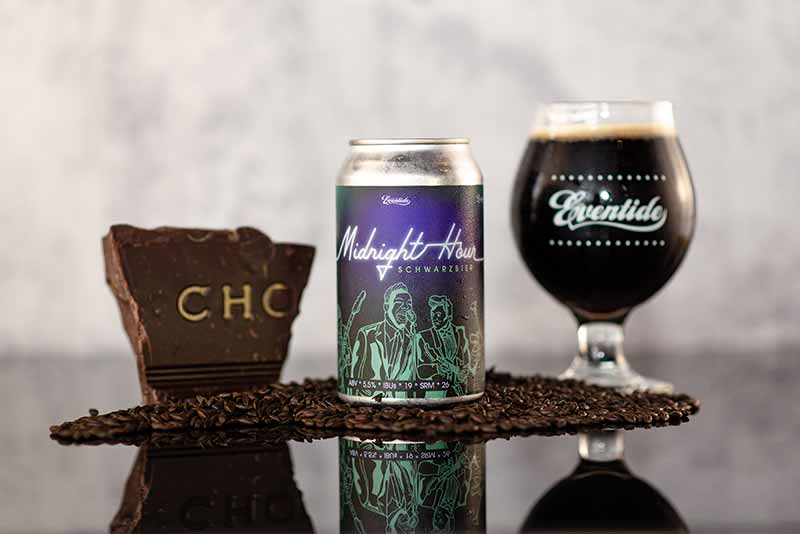
We’ve written about the best way to brew several traditional European beers: Märzen, Czech pilsner, Belgian tripel, helles lager, and Berliner weisse, to name a few. As we are nearing the hotter months of the year, an old-world lager like schwarzbier warrants discussion.
We chatted with Eventide Brewing Head Brewer Adam Lukey and Enegren Brewing Founder Chris Enegren to learn all about the style, the sweet spot for ABV, the most crucial considerations, and some tips for crafting a superb take on the style.
(Above photography courtesy of Eventide Brewing)
What We’ll Cover in This Piece:
Affordable, Industry-Leading Brewery Software
How the Experts Define Schwarzbier

Photography courtesy of Enegren Brewing
A German word that translates to dark lager, schwarzbier balances the roasted but smooth malt flavors with moderate hop bitterness. The style should have a lighter body and some dryness, and, despite the roasted malts, it should lack a harsh, burnt aftertaste.
When ten-year brewing pro Lukey crafts traditional beers such as a schwarzbier, he leans heavily on the BJCP guidelines. He likes to refer to schwarzbier as a dark beer for people who say they don’t like dark beer.
“They think it’s heavy and sweet, but schwarzbier is the opposite,” Lukey says. “It’s super light. It’s a lager. It’s dry. You get roasty notes, but it’s never burnt-tasting. It’s very drinkable.”
Lukey adds that you should get a light roast—like coffee and chocolate—on the nose, with Noble hops to balance the sweetness. One contention he has with schwarzbier and the guideline is the translation to “dark lager.”
“Dark is a relative term,” Lukey says. “It should be dark in the glass, but if you shine a light on it, it should be ruby.”
The BJCP guidelines describe the beer as “medium to very dark brown in color, often with deep ruby to garnet highlights, yet almost never truly black.”
Enegren describes schwarzbier as an easy-drinking beer.
“A good schwarzbier, you can drink at the beach on a hot day. It’s my favorite beer out in the sun,” Enegren says. “It has a lighter body. The roasted, dark chocolaty malts aren’t in your face but are noticeable.”
He adds, “You can drink one after another and not get burnt out by it. That’s how German beers are typically.”
Is There a Place for Schwarzbier?

Photography courtesy of Eventide Brewing
Lukey says schwarzbier almost faced extinction in 1989, noting that, at the time, no one had heard of the style outside its origin area of Germany. But now, he believes the style is a classic that isn’t going anywhere.
“People might have had bad examples of a schwarzbier [in the past],” Lukey says. “People who brew classics, it’ll always be an option … as long as they do right by [the style].”
Lukey says there is seasonality to it, however.
“Late summer through winter is when it does its best,” he says.
Enegren says that keeping classic styles like schwarzbier alive is about education.
“There is a conception that dark is not refreshing,” says Enegren, pointing out how a customer who enjoyed iced coffee, which is dark and refreshing, also liked his schwarzbier. “That’s something people will learn as they go. We keep pushing them that way and try to educate more people.”
Enegren adds, “We have to help them make that distinction. … It’s not the same as a stout. Pilsner and IPA look the same but are ages different in taste. It’s the same thing with stout and schwarzbier.”
What Are the Top Considerations When Brewing Schwarzbier?

Photography courtesy of Enegren Brewing
Lukey reiterates the need to aim for dark brown with ruby highlights.
“You want to watch out for astringencies,” Lukey says. “I would use a de-bittered dark malt. … Don’t overdo it with the roast malt. It should be clean, highly carbonated, and easy to drink.”
Enegren says the same thing as Lukey: Don’t overdo the black malt.
“Look for something de-bittered like a Carafa—between II and III,” Enegren says. “You can go Pilsner and just that [Carafa]. Or add Vienna malt as well.”
Enegren says that the hops aren’t vital to the beer; they just balance it out. But he points to several things that need to be dialed in if you want an excellent finished product.
“Cold-fermenting, filtering, it’s all important,” he says. “And good mash complexity. Layers of complexity. Step mashing helps.”
Enegren says there are different paths to the right end goal. One is to add the dark malts during the sparging process.
“That gave us different effects,” Enegren says. “We got the dark color easily, but the roasted quality was different.”
They used that technique to achieve color in other beers but felt that it lost some of the flavors they wanted in the schwarzbier.
“Ultimately, we went back to what we did before [putting dark malts in the mash],” he says. “We’ve locked into our process for three-plus years now.”
Lukey says he doesn’t mash with the dark malts. He says that helps him control the pH.
“I use the light malts for the mash and add the Midnight Wheat during vorlauf and sparge to get mostly color and some roast,” Lukey says.
Lukey stresses the need to control your water. In Germany, he says, they had hard water. They try to adjust their water to avoid any off-flavors.
“You’d be amazed what a little water chemistry does to make an excellent beer,” he says. “I keep the sulfates low. I don’t use gypsum. I add one hundred ppm of carbonate and fifty to one hundred ppm of chloride.”
Lukey adds, “It makes the mouthfeel fuller with a touch of minerality.”
What Is a Typical Schwarzbier Grist Bill?

Photography courtesy of Eventide Brewing
Enegren says the majority of it is Pilsner malts. You can add a bunch of darker malts, but if you add too much, you enter more of a dunkel than a schwarzbier.
“A good starting point is about ninety-two percent Pilsner malt and eight percent of Carafa II,” Enegren says. “Then, from there, you can decide if you want to go heavier on Carafa. If you want body, you can add Munich I.”
Eventide brews five-barrel batches. Like Enegren, Lukey goes with a majority of Pilsner.
“We use four bags of Pilsner, one bag of dark Munich, and a half bag of chocolate wheat, which we throw in at vorlauf,” Lukey says. “We mash at 150 degrees Fahrenheit. You could mash at 148 degrees Fahrenheit to make it drier.”
How to Dial in IBUs and Hops for Schwarzbier
The BJCP says the IBUs for a schwarzbier should be between twenty and thirty-five.
“We do a sixty-minute boil of any traditionally high-alpha acid hop like CTZ or Magnum,” Lukey says. We are on the lower end of the [BJCP spectrum] at twenty IBUs.”
He adds, “We use Tettnang for a flavor and aroma hop, adding it at the end of the boil with five minutes. I want that woodsyness and herbalness to counteract residual sweetness.”
Conversely, Enegren says they shoot for the higher end of the spectrum.
“We shoot for thirty-four IBUs on this one,” he says. “We like Hallertau in our schwarzbier. We do a sixty-minute boil with Herkules, which gets us most of the way. Then, add Hallertau at fifteen minutes.”
What Is an Ideal ABV for Schwarzbier?

Photography courtesy of Eventide Brewing
The style guidelines call for 4.4% ABV to 5.4% ABV. Enegren’s preference lands somewhere in the middle, while Lukey aims for the higher end.
“Ours comes out to about 4.8% ABV,” Enegren says. “It is a good sweet spot for complexity and malt character without going too low.”
He adds, “German beer is lower on the ABV side and maltier typically. The goal is to make a beer that tastes great and [that you] can drink all day long. That’s what you get [with] this beer.”
Lukey says their schwarzbier is about 5.4% ABV.
“You can go lower alcohol and dip into the fours,” he says. “I don’t think there was any particular reason behind me going higher.”
Two Great Examples of Schwarzbier
Enegren has its Nighthawk, a traditional schwarzbier at 4.8% ABV with twenty-eight IBUs, that smells of earthy dark roasted coffee with notes of dark chocolate.
“We try to balance the crispness of the beer but also give that malt background,” Enegren says. “We keep it subtle, but when you taste a black lager, you want those flavors to be out there as well.”
Eventide makes Midnight Hour, a 5.5% ABV schwarzbier with nineteen IBUs. Lukey says the color is about 25 SRM, and he shoots for 2.6 volumes of CO2 because it tends to lighten up under 2.5 volumes.
“You want liveliness to open up those roasty flavors,” Lukey says. “That’s what I like about ours.”



